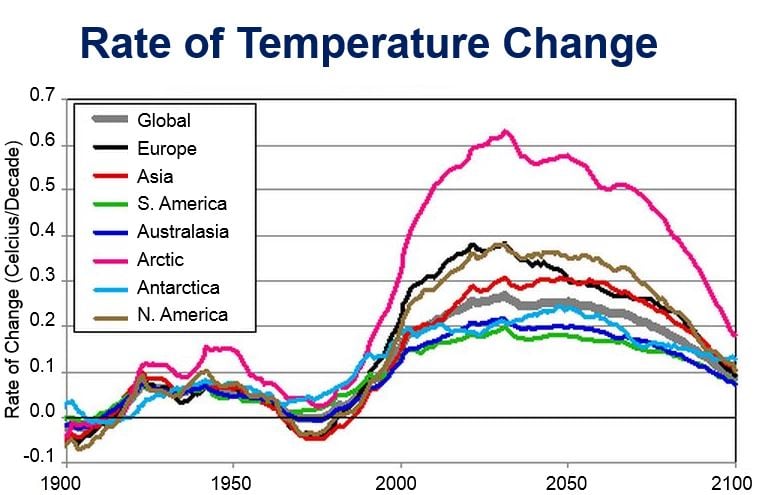Start adapting to living in a warming world, researchers warn, because an analysis of climate changes that occur over several decades shows that these temperature changes are occurring more rapidly than historical levels, and are starting to accelerate even faster.
Our planet is now entering a much faster climate change phase compared to fluctuations seen over the past thousand years, researchers from the Department of Energy’s Pacific Northwest National Laboratory wrote in the academic journal Nature Climate Change.
Whether we like it or not, we are going to have to adapt to a hotter planet, they say.
Interdisciplinary scientist Dr. Steve Smith and colleagues gathered and analyzed data on historical and projected changes over decades instead of centuries to work out what temperature trends humans who are alive today are likely to experience during their lifetimes.

The rate at which temperatures change is rising and will continue to do so, as seen on this graph, with the thick grey (US: gray) line. This model shows rates measured in forty-year windows of time, a time-frame that reflects the lifespans of most people. (Image: www.pnnl.gov/)
Lead author, Dr. Smith, said:
“We focused on changes over 40-year periods, which is similar to the lifetime of houses and human-built infrastructure such as buildings and roads. In the near term, we’re going to have to adapt to these changes.”
Overall, our planet is getting warmer as a result of increasing greenhouse gases in the atmosphere that trap heat. However, it is not a smooth increase – temperatures fluctuate along the way.
Time scales relevant to people today
Although scientists know about natural changes in temperature, they know less about how rapidly temperature changed in the past and will do so in the future over time-scales that are relevant to society, such as the lifetimes of people who are alive at the moment.
Having reliable data on how climate may change within our lifetimes could help policy-makers better prepare for the possible impacts.
To study rates of change, Dr. Smith and a team of scientists at the Joint Global Change Research Institute, a collaboration between PNNL and the University of Maryland in College Park, turned to the CMIP (Coupled Model Intercomparison Project) which combines simulations from more than twenty climate models from across the globe to compare model results.
Every CMIP model used the same data for past and future greenhouse gas atmospheric concentrations, pollutant emissions, and changes in land usage, which can emit or absorb greenhouse gases. The confidence in the results depends on how many models are in agreement.
The team calculated the rate of temperature change between 1850 and 1930, a period when record-keeping began, but when the amount of fossil fuel gases emitted into the atmosphere was low.
These rates were compared to temperature fluctuations over the last 2,000 years by gathering information from natural sources, such as ice cores, corals and tree rings.
Taken together, the 1850 to 1930 time period simulation was similar to the reconstructions over longer periods, suggesting the models reflected reality accurately.
From 0.2°C to 0.3°C change
While the early period registered little average global temperature increase, Earth’s temperature fluctuated due to natural variability. Rates of change over 4-decade periods in Europe and North America increased and declined as much as 0.2 degrees Celsius per decade. The reconstructions and computer models largely agreed on these rates of natural fluctuations, suggesting that the models provided a good representation of trends over a 4-decade scale.
The researchers then performed a similar analysis using CMIP, but this time looking at 40-year rates of change between 1971 and 2020. Here, they found the average rate of temperature change over North America, for example, was approximately 0.3 degrees Celsius per decade, which was higher than the fluctuations due to natural variability.
According to the CMIP models, most regions in the world are currently completely outside the natural range for rates of temperature change.
Future warming will accelerate, regardless of emission rates
The scientists also looked at possible scenarios of future emissions, and worked out what the rates of change might be. In every single case global warming accelerated over the next forty years, even in scenarios where future greenhouse gas emissions were lower.
The researchers wrote “A scenario where greenhouse gas emissions remained high resulted in high rates of change throughout the rest of this century.”
Dr. Smith and colleagues said they could not say exactly what impact faster rising temperatures might have on the Earth and the people and other forms of life that inhabit it.
Dr. Smith said:
“In these climate model simulations, the world is just now starting to enter into a new place, where rates of temperature change are consistently larger than historical values over 40-year time spans. We need to better understand what the effects of this will be and how to prepare for them.”
The study was funded by the Department of Energy Office of Science.
Citation: “Near-term acceleration in the rate of temperature change, Nature Climate Change,” Steven J. Smith, James Edmonds, Corinne A Hartin, Anupriya Mundra, and Katherine Calvin. Nature Climate Change. Published March 9, 2015. DOI: 10.1038/nclimate2552.
